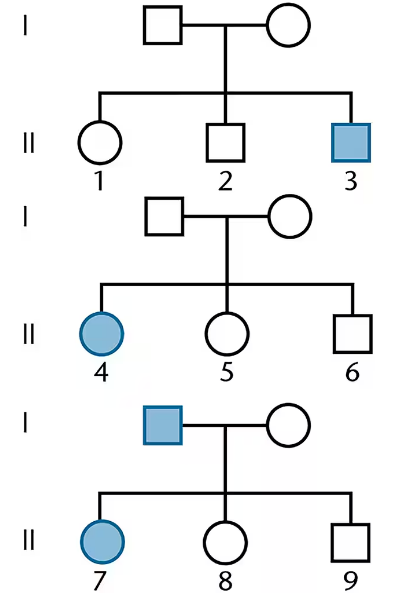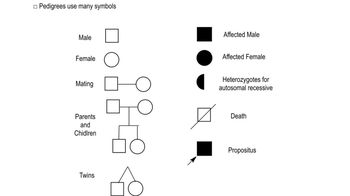Table of contents
- 1. Introduction to Genetics51m
- 2. Mendel's Laws of Inheritance3h 37m
- 3. Extensions to Mendelian Inheritance2h 41m
- 4. Genetic Mapping and Linkage2h 28m
- 5. Genetics of Bacteria and Viruses1h 21m
- 6. Chromosomal Variation1h 48m
- 7. DNA and Chromosome Structure56m
- 8. DNA Replication1h 10m
- 9. Mitosis and Meiosis1h 34m
- 10. Transcription1h 0m
- 11. Translation58m
- 12. Gene Regulation in Prokaryotes1h 19m
- 13. Gene Regulation in Eukaryotes44m
- 14. Genetic Control of Development44m
- 15. Genomes and Genomics1h 50m
- 16. Transposable Elements47m
- 17. Mutation, Repair, and Recombination1h 6m
- 18. Molecular Genetic Tools19m
- 19. Cancer Genetics29m
- 20. Quantitative Genetics1h 26m
- 21. Population Genetics50m
- 22. Evolutionary Genetics29m
2. Mendel's Laws of Inheritance
Pedigrees
Problem 30b
Textbook Question
Consider the three pedigrees below, all involving a single human trait.

For each combination that you excluded, indicate the single individual in generation II (e.g., II-1, II-2) that was most instrumental in your decision to exclude it. If none were excluded, answer 'none apply.'
 Verified step by step guidance
Verified step by step guidance1
Step 1: Analyze the inheritance pattern in the pedigree chart. Determine whether the trait follows autosomal dominant, autosomal recessive, X-linked dominant, or X-linked recessive inheritance based on the distribution of affected individuals across generations.
Step 2: Focus on individuals in generation II, as they are key to understanding the inheritance pattern. Examine their phenotypes and relationships to other individuals in the pedigree.
Step 3: For each inheritance pattern, identify whether it can be excluded based on the phenotypes of individuals in generation II. For example, if an affected individual has unaffected parents, autosomal dominant inheritance can be excluded.
Step 4: Determine the specific individual in generation II (e.g., II-1, II-2, etc.) whose phenotype provides the most evidence for excluding a particular inheritance pattern. This individual will be instrumental in your decision.
Step 5: If no inheritance patterns are excluded based on the analysis, conclude that 'none apply.' Otherwise, specify the individual in generation II who was most instrumental in excluding a pattern.
 Verified video answer for a similar problem:
Verified video answer for a similar problem:This video solution was recommended by our tutors as helpful for the problem above
Video duration:
4mPlay a video:
Was this helpful?
Key Concepts
Here are the essential concepts you must grasp in order to answer the question correctly.
Pedigree Analysis
Pedigree analysis is a genetic tool used to trace the inheritance patterns of traits through generations in a family. It visually represents relationships and can indicate whether a trait is dominant, recessive, or linked to sex chromosomes. By analyzing the pedigree, one can identify carriers and predict the likelihood of offspring inheriting specific traits.
Recommended video:
Guided course

Pedigree Flowchart
Dominant and Recessive Traits
In genetics, traits can be classified as dominant or recessive based on their expression in individuals. A dominant trait only requires one copy of the allele to be expressed, while a recessive trait requires two copies. Understanding these concepts is crucial for interpreting pedigrees, as it helps determine which individuals may carry or express certain traits.
Recommended video:
Guided course

Variations on Dominance
Generational Notation
Generational notation in pedigrees uses Roman numerals to denote generations and Arabic numerals to identify individuals within those generations. For example, 'II-1' refers to the first individual in the second generation. This notation is essential for accurately discussing and analyzing specific individuals in the context of inheritance patterns.
Recommended video:
Guided course

Pedigree Symbols
Related Videos
Related Practice
Textbook Question
For decades scientists have been perplexed by different circumstances surrounding families with rare, early-onset auditory neuropathy (deafness). In some families, parents and grandparents of the proband have normal hearing, while in other families, a number of affected (deaf) family members are scattered throughout the pedigree, appearing in every generation. Assuming a genetic cause for each case, offer a reasonable explanation for the genetic origin of such deafness in the two types of families.
508
views


